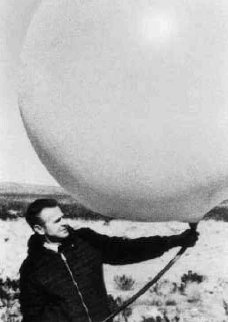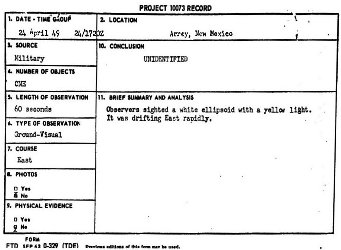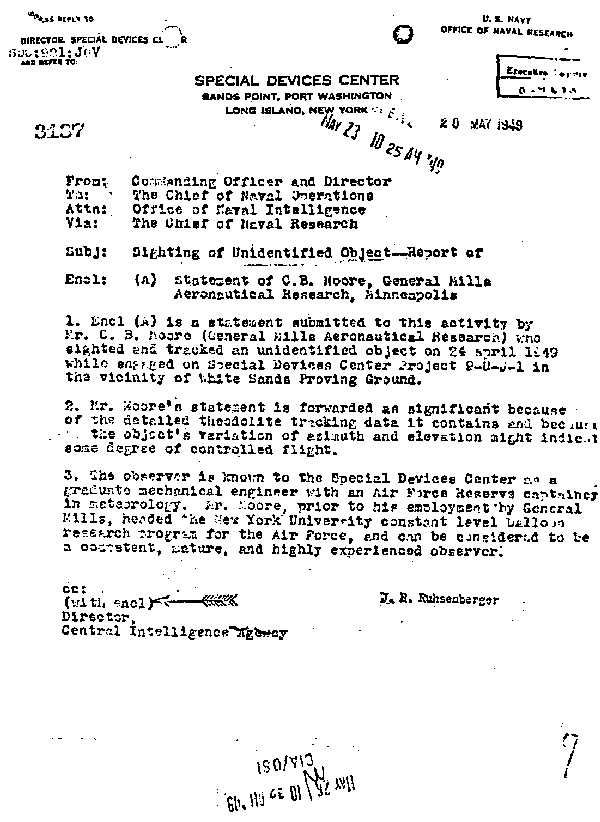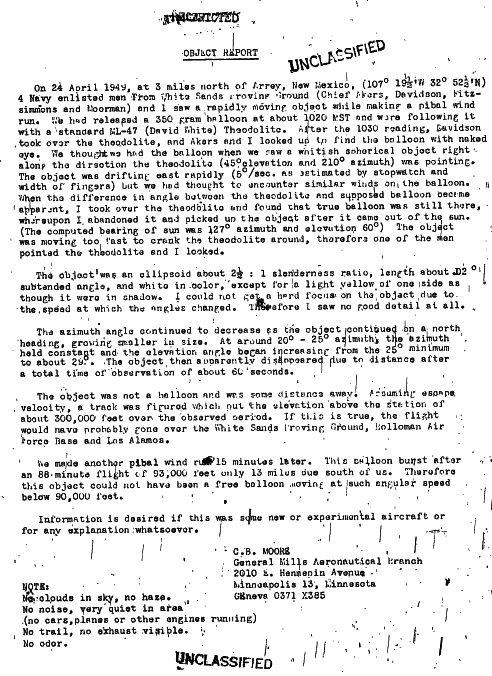
Charles B. Moore. |
"I knew the two pilots of the C-47; both of them now believe in flying saucers. And they aren't alone; so do the people of the Aeronautical Division of General Mills who launch and track the big Skyhook balloons. These scientists and engineers all have seen UFO's and they aren't their own balloons. I was almost tossed out of the General Mills offices into a cold January Minneapolis snowstorm for suggesting such a thing but that comes later in our history of the UFO." Captain Edward J. Ruppelt, US Air Force head UFO investigator. |

|
|
In the end of the 40's, an alternative method to the expensive, highly demanded and rare supersonic wind tunnels to test aerodynamics of supersonic aircraft and rockets was devised by Lieutenant Commander George Hoover of the Office of Naval Research (ONR) Special Devices Center: to take the object to test to stratospheric altitude using a high altitude balloon, drop it and observe its behaviour in the supersonic descent.
Hoover found that the new plastic high-altitude balloons being developed by the General Mills balloon group in Minneapolis could indeed lift significant payloads high enough, and the experiments, designated "9-U-J-1 Free Fall Test Vehicle (FFTV)" started, using three Skyhook plastic balloons of seventy-three feet in diameter when fully inflated, arranged in a cluster and connected to the fifteen foot long projectile by a tether system, and dropping the FFTV at an altitude of about 100,000 feet.
The balloons were launched from near Las Cruces in New Mexico and drift over the White Sands Proving Ground range into a test area where optical and radar tracking systems could observe the test vehicle launched over the range.
On April 24, 1949, a team of White Sands technicians was studying the upper atmosphere from the test area, about three miles north of Arrey, New Mexico. General Mills engineer professor Charles B. Moore - who later became famous due to his involvement the Mogul balloon project in 1947 - with four Navy enlisted men, Chief Akers, and three men named Davidson, Fitzsimmons and Moorman, were launching small neoprene pilot balloons to measure winds directions and wind speeds to help predict the flight path of the actual FFTV Skyhook system scheduled to be launched a few day later.
One of the four Navy enlisted men assisting Moore was observing the pilot balloon through a theodolite. (A theodolite is a triangulation telescope, used to track and measure the angular vertical and horizontal displacement of their target). Moore saw a white object that he thought was the balloon and noticed that the theodolite was pointed toward a different part of the sky. He thought that the enlisted man had lost track of the balloon and pointed it out to him. But the enlisted insisted that he had the balloon in sight, so Moore took over the theodolite and pointed it at this different object. Through the 25-power scope, he could see that it was an ellipsoidal white object with some light yellow. Moore said the object was about three times as long as it was thick, and was about one minute of arc in angular diameter, or when viewed through the 25-power theodolite, would appear about three quarter of the size of the full moon with unaided vision. The object was moving at a rapid angular speed of 5 degrees per second towards the northeast, but before it went out of sight in the northeast, it started to climb in altitude.
Another balloon was launched to determine whether there was a high-speed air current that would have carried the object from southwest to northeast. It was found that there were no air currents moving in that direction, only a weak one moving at right angles to the object's path, and Moore understood that the object had its own flight control.
The incident leaked out in the newspaper, then in 1950 US Navy officer McLaughlin published the famous article in True Magazine and caused quite a sensation.
A year later LIFE magazine briefly described it in their famous article Have we visitors from outers space?:
On April 24, 1949, at 10:20 a.m., a group of five technicians under the general supervision of J. Gordon Vaeth, an aeronautical engineer employed by the Office of Naval Research, were preparing to launch a Skyhook balloon near Arrey, N. Mex. A small balloon was sent up first to check the weather. Charles B. Moore Jr., an aerologist of General Mills Inc. (pioneers in cosmic ray research) was tracking the weather balloon through a theodolite - a 25-power telescopic instrument, which gives degrees of azimuth and elevation (horizontal and vertical position) for any object it is sighted on. At 10:30 a.m. Moore leaned back from the theodolite to glance at the balloon with his naked eye. Suddenly he saw a whitish elliptical object, apparently much higher than the balloon, and moving, in the opposite direction. At once he picked the object up in his theodolite at 45 degrees of elevation and 210 degrees of azimuth, and tracked it east at the phenomenal rate of 5 degrees of azimuth-change per second as it dropped swiftly to an elevation of 25 degrees. The object appeared to be an ellipsoid roughly two and a half times as long as it was wide. Suddenly it swung abruptly upward and rushed out of sight in a few seconds. Moore had tracked it for about 60 seconds altogether. The other members of his crew confirmed his report. No sound was heard, no vapor trail was seen. The object, according to rough estimations by Moore and his colleagues, was about 56 miles above the earth, 100 feet long and was traveling at seven miles per second.
No known optical or atmospheric phenomenon fits the facts. A natural object traveling at seven miles per second has never been seen to make a sudden upward turn. There is no known or projected source of silent, vaporless power for such a machine. No human being could have borne the tremendous "G" load brought to bear on the craft during its abrupt vertical veer.
The US Air Force investigated UFO sighting reports within the frame of their project Blue Book, whose first leader Captain Edward Ruppelt was motivated to deal with these. He reported in his book:
I knew the two pilots of the C-47; both of them now believe in flying saucers. And they aren't alone; so do the people of the Aeronautical Division of General Mills who launch and track the big Skyhook balloons. These scientists and engineers all have seen UFO's and they aren't their own balloons. I was almost tossed out of the General Mills offices into a cold January Minneapolis snowstorm for suggesting such a thing but that comes later in our history of the UFO.
And:
While I travelled around the United States getting the project set up, UFO reports continued to come in and all of them were good. One series of reports was especially good, and they came from a group of people who had had a great deal of experience watching things in the sky - the people who launch the big skyhook balloons for General Mills, Inc. The reports of what the General Mills people had seen while they were tracking their balloons covered a period of over a year. They had just sent them in because they had heard that Project Grudge was being reorganized and was taking a different view on UFO reports. They, like so many other reliable observers, had been disgusted with the previous Air Force attitude toward UFO reports, and they had refused to send in any reports. I decided that these people might be a good source of information, and I wanted to get further details on their reports, so I got orders to go to Minneapolis. A scientist from Project Bear went with me. We arrived on January 14, 1952, in the middle of a cold wave and a blizzard.
The Aeronautical Division of General Mills, Inc., of Wheaties and Betty Crocker fame, had launched and tracked every skyhook balloon that had been launched prior to mid 1952. They knew what their balloons looked like under all lighting conditions and they also knew meteorology, aerodynamics, astronomy, and they knew UFO's. I talked to these people for the better part of a full day, and every time I tried to infer that there might be some natural explanation for the UFO's I just about found myself in a fresh snowdrift.
What made these people so sure that UFO's existed? In the first place, they had seen many of them. One man told me that one tracking crew had seen so many that the sight of a UFO no longer even especially interested them. And the things that they saw couldn't be explained.
For example: On January 16, 1951, two people from General Mills and four people from Artesia, New Mexico, were watching a skyhook balloon from the Artesia airport. They had been watching the balloon off and on for about an hour when one of the group saw two tiny specks on the horizon, off to the northwest. He pointed them out to the others because two airplanes were expected into the airport, and he thought that these might be the airplanes. But as they watched, the two specks began to move in fast, and within a few seconds the observers could see that "the airplanes" were actually two round, dull white objects flying in close formation. The two objects continued to come in and headed straight toward the balloon. When they reached the balloon they circled it once and flew off to the northwest, where they disappeared over the horizon. As the two UFO's circled the balloon, they tipped on edge and the observers saw that they were disk shaped.
When the two UFO's were near the balloon, the observers also had a chance to compare the size of the UFO's with the size of the balloon. If the UFO's were as close to the balloon as they appeared to be they would have been 60 feet in diameter.
After my visit to General Mills, Inc., I couldn't help remembering a magazine article I'd read about a year before. It said that there was not a single reliable UFO report that couldn't be attributed to a skyhook balloon.
Within two weeks after the sighting, AFOSI (the scientific investigation office of the Air Force) investigators had visited and interviewed the witnesses and put their statements on record. Then Moore's report landed on Project Grudge's desk, and a Dr. Fitts for evaluation. But at the time, the Air Force was supposed to discard UFOs as ridiculous and Dr. Fitts did not study the report and just wrote back that the subject was not worthy of any such investigation due to lack of reliable data.
However, although Grudge head Colonel Watson was totally "anti-UFO", he had to admit that Moore's sighting has no commonplace explanation. The sighting was also studied at the AMC (Air Material Command), and the conclusion by their Chief of the Aircraft Projects Section of the Engineering Division, Colonel George F. Smith, was, on July 27, 1949:
"This Office can give no hint of identification or possible origin of these objects as described."
General Mills people were shocked of the casual treatment, since nothing of value was answered to them, and subsequently General Mills officials wrote to the Assistant Secretary of the AF concerning this sighting and other sightings by their scientists and technicians. Simultaneously, Project Grudge had been revamped and named Project Blue Book, headed by Edward Ruppelt. Ruppelt started by reopening Grudge cases and this is why he visited General Mills people. However, he tried to debunk the Moore sighting as a balloon, and this is why the scientists there almost threw him out. Ruppelt failed to request that further sightings are referred to his service, and simply gave some blank CIRVIS reporting forms. As a result, General Mills people were very unhappy and stopped reporting further sightings to the Air Force.
This is the "explanation" of the sighting by Dr. Menzel in his book "Flying Saucers" on page 31:
"This incident, kept in the classified files for more than two years, presents no serious difficulty to the person who understands the optics of the earth's atmosphere. The air can, under special conditions, produce formations similar to lenses. And, just as a burning glass can project the sun into a point of light, so can these lenses of air, imperfect though they are, form an image. What Moore saw was an out-of-focus and badly astigmatic image of the balloon above. If you happen to wear fairly strong lenses in your glasses, whether you are nearsighted or farsighted, take them off and hold them at arm's length and try to view a distant, luminous object like a candle, electric light, or street lamp. You will see, far beyond the real object and at a considerable angle to it, an apparent image of the candle itself. As you move the lens, the image will appear to maneuver. As mentioned earlier, we here have to defer the discussion of how lenses of air play an important role in the formation of many varieties of flying saucers. We must remember that these lenses are crooked and bent, and often "dirty" as well. The dirt consists of layers of dust or fog between us and the object at which we are looking. No wonder that sometimes we get a distorted view, and imagine that the saucers we see are real!"
Of course the explanation by a "mirage" cause by a "lense" formed by "the air, in special conditions" is not one bit compatible with the observation's data, and other scientists demonstrated in details and in quantitative manner the several reasons why this explanation is nonsensical, but of course, the "debunking hero" status acquired by Dr. Menzel by promoting any nonsensical explanation when anything out of this world may have been a possible cause to a UFO report was never questioned by his "skeptics" admirers, who should have, were they unbiased, denounced the pseudo-science at work here. To them, any pseudo-scientific "explanation" is better than the perspective of facing the supposedly "irrational", intolerable - to them - notion of extraterrestrial visits.
Dr. Menzel did not speak to the witnesses and his working material for the case was only a short article in LIFE Magazine. Much later, Dr. Maccabee, a scientist who has devoted much time in in-depth examination of this case and many others pointed out that Dr. Menzel nevertheless should have understood that the mirage explanation does not hold even based on the data in LIFE Magazine. Maccabee further comments that "it is important to note that an intelligent person, even one with no knowledge of atmospheric physics, could have discovered the error in Menzel's explanation if Menzel had included the factual data from the sighting in his book."
Unlike Dr. Menzel, Dr. Maccabee did contact the main witness Charles B. Moore, and asked him his thoughts on Dr. Menzel's explanation, in 1986. Moore answered:
"Although I had met Donald Menzel during the late 1950's in connection with John Strong's studies of Venus, he never discussed our earlier report of a peculiar flying object over Arrey, New Mexico in 1949. What I saw was not a mirage; it was a craft with highly unusual performance. It was not a balloon; at that time we were the innovators and manufacturers of the new balloons and I certainly would have known about any new developments as I was newly in charge of General Mills' balloon operations. It was not the X-1, which was in its hangar at Muroc that Sunday. It was nothing from White Sands nor from Alamogordo AFB for we were in radio contact with Range Control and were informed that our operation was the only one active on Sunday. For these reasons, I'm cynical about Menzel and his approach to science."
Another attempted commonplace explanation, which is certainly less nonsensical, was by ufologist Brad Sparks: the object could have been a bouncing meteor. The bounce is necessary since the object changes courses and goes upwards at the end of its observed path. Indeed, in rare occasions, a meteor can skip back to space when it hits the earth's atmosphere at an appropriate angle. However, meteors, including bouncing meteors, do leave a trail caused by their friction in the atmosphere, and in this case absolutely no trail was observed. Other factors, such as the duration of the sighting, also make it reasonable to discard a bouncing meteorite. After discussions and evaluations of the bouncing meteorite possibility among ufologists, it was thus discarded.

|
SPECIAL DEVICES CENTER
SANDS POINT, PORT WASHINGTON
LONG ISLAND, NEW YORK
20 MAY 1949
| From: | Commanding Officer and Director |
| To: | The Chief of Naval Operations |
| Attn: | Office of Naval Intelligence |
| Via: | The Chief of Naval Research |
| Subj: | Sighting of Unidentified Object -- Report of |
| Encl: | (A) Statement of C.B. Moore, General Mills Aeronautical Research, Minneapolis |
1. Encl (A) is a statement submitted to this activity by Mr. C. B. Moore (General Mills Aeronautical Research) who sighted and tracked an unidentified object on 24 April 1949 while engaged on Special Devices Center Project P-U-J-1 in the vicinity of White Sands Proving Ground.
2. Mr. Moore's statement is forwarded as significant because of the detailed theodolite tracking data it contains and because the object's variation of azimuth and elevation might indicate some degree of controlled flight.
3. The observer is known to the Special Device Center as a graduate mechanical engineer with an Air Force Reserve captaincy in meteorology. Mr. Moore, prior to his employment by General Mills, headed the New York University constant level balloon research program for the Air Force [i.e., Mogul], and can be considered to be a competent, mature, and highly experienced observer.
J. R. Ruhsenberger
cc:
(with encl)
Director
Central Intelligence Agency

|
OBJECT REPORT
On 24 April 1949, at 3 miles north of Arrey, New Mexico, (107 degrees 19.5' W 300 deg 52.5' N) 4 Navy enlisted men from White Sands Proving Ground (Chief Akers, Davidson, Fitzsimmons and Moorman) and I saw a rapidly moving object while making a pibal wind run. We had released a 350 gram balloon at about 1020 MST and were following it with a standard ML-47 (David White) Theodolite. After the 1030 reading, Davidson took over the theodolite, and Akers and I looked up to find the balloon with naked eye. We thought we had the balloon when we saw a whitish spherical object right along the direction the theodolite 45 degree elevation and 210 degree azimuth) was pointing. The object was drifting east rapidly (5 degrees/sec. as estimated by stopwatch and width of fingers) but we had thought to encounter similar winds on the balloon. When the difference in angle between the theodolite and supposed balloon became apparent, I took over the theodolite and found the true balloon still there, whereupon I abandoned it and picked up the object after it came out of the sun. (The computed bearing of sun was 127 degrees azimuth and elevation 60 degrees). The object was moving too fast to crank the theodolite around, therefore one of the men pointed the theodolite and I looked.
The object was an ellipsoid about 2.5:1 slenderness ratio, length about .02 degrees subtended angle, and white in color, except for a light yellow of one side as though it were in shadow. I could not get a hard focus on the object due to the speed at which the angles changed. Therefore I saw no good detail at all.
The azimuth angle continued to decrease as the object continued on a north heading, growing smaller in size. At around 20 degrees - 25 degrees Azimuth, the Azimuth held constant and the elevation angle began increasing from the 25 degree minimum to about 29 degrees. The object then apparently disappeared due to distance after a total time of observation of about 60 seconds.
The object was not a balloon and was some distance away. Assuming escape velocity, a track was figured which put the elevation about the station of about 300,000 feet over the observed period. If this is true, the flight would have probably gone over the White Sands Proving Ground, Holloman Air Force Base and Los Alamos.
We made another pibal wind run 15 minutes later. This balloon burst after an 88 minute flight of 93,000 feet only 13 miles due south of us. Therefore this object could not have been a free balloon moving at such angular speed below 90,000 feet.
Information is desired if this was some new or experimental aircraft or for any explanation whatsoever.
C.B. Moore
General Mills Aeronautical Research
2010 H. Hennepin Avenue
Minneapolis, 13, Minnesota
Geneva 0371 X 385
NOTE:
No clouds in sky, no haze.
No noise, very quiet in area
(no cars, planes or other engines running)
No trail, no exhaust visible.
No odor.